#The Granary Bristol
Text

IRON FIST & THE HORDES FROM HELL -- GIGGING IN THE HOME BASE OF AMEBIX.
PIC INFO: Spotlight on the mighty MOTÖRHEAD, classic line-up, performing live at the Old Granary, Bristol, UK, c. 1979.
^Not a location in the UK that you hear mentioned very often when it comes to past Motörmusic gigs, so, I thought that was worth a mention. Notably, CHAOS UK and DISORDER were also from Bristol. Solid.
Source: www.flickr.com/photos/pftgg/7457413262.
#MOTÖRHEAD#MOTÖRHEAD 1979#Fast Eddie Clarke#Lemmy Kilmister#Rocknroll#Photography#Motörmasters#SuperSeventies#1979#Bomber 1979#Overkill 1979#Philthy Animal Taylor#Rock'n'roll#Metalpunk#RockandRoll#Power Trio#1970s#70s#Motörmusic#Bristol UK#Bristol#The Granary Bristol#The Granary Bristol UK#Rock and roll
18 notes
·
View notes
Text

Frank Dicksee (British painter and illustrator) 1853 - 1928
La Belle Dame Sans Merci, ca. 1902
oil on canvas
13 x 18 cm. (5.12 x 7.09 in.)
Bristol City Museum and Art Gallery, Bristol, United Kingdom
© photo Bristol City Museum and Art Gallery,
La Belle Dame sans Merci is a ballad written by the English poet John Keats. It exists in two versions, with minor differences between them. The original was written by Keats in 1819. He used the title of a 15th century poem by Alain Chartier, though the plots of the two poems are different. The poem is considered an English classic, stereotypical to other poems of John Keats, a Romantic poet. It avoids simplicity of interpretation despite simplicity of structure. At only a short twelve stanzas, of only four lines each, with a simple ABCB rhyme scheme, the poem is nonetheless full of enigmas, and has been the subject of numerous interpretations.
Keats' poem describes the condition of an unnamed knight who has encountered a mysterious woman who is said to be "a faery's child." It opens with a description of the knight in a barren landscape, "haggard" and "palely loitering". He tells the reader how he met a mysterious but very fair lady whose "eyes were wild." The damsel told the knight that she "loved him true" and took him to her "elfin grot," but upon arriving there, she "wept, and sigh'd full sore." Having realized something that the knight does not yet understand, the mysterious maiden sets the knight to sleep. The knight has a vision of "pale kings and princes," who cry, "La Belle Dame sans Merci [the beautiful, pitiless damsel] hath thee in thrall!" He awakes to find himself on the same "cold hill's side" on which he continues to wait while "palely loitering."
"La Belle Dame sans Merci" was a popular subject for the Pre-Raphaelite painters. It was depicted by Sir Frank Dicksee, Frank Cadogan Cowper, John William Waterhouse, Arthur Hughes, Walter Crane, and Henry Maynell Rheam. It was also satirized in the December 1, 1920 edition of Punch magazine.
* * *
This painting is based on La Belle Dame Sans Merci by John Keats.
La Belle Dame Sans Merci
I
Ah, what can ail thee, wretched wight,
Alone and palely loitering;
The sedge is wither'd from the lake,
And no birds sing.
II
Ah, what can ail thee, wretched wight,
So haggard and so woe-begone?
The squirrel's granary is full,
And the harvest's done.
III
I see a lily on thy brow,
With anguish moist and fever dew;
And on thy cheek a fading rose
Fast withereth too.
IV
I met a lady in the meads
Full beautiful, a faery's child;
Her hair was long, her foot was light,
And her eyes were wild.
V
I set her on my pacing steed,
And nothing else saw all day long;
For sideways would she lean, and sing
A faery's song.
VI
I made a garland for her head,
And bracelets too, and fragrant zone;
She look'd at me as she did love,
And made sweet moan.
VII
She found me roots of relish sweet,
And honey wild, and manna dew;
And sure in language strange she said,
I love thee true.
VIII
She took me to her elfin grot,
And there she gaz'd and sighed deep,
And there I shut her wild sad eyes -
So kiss'd to sleep.
IX
And there we slumber'd on the moss,
And there I dream'd, ah woe betide,
The latest dream I ever dream'd
On the cold hill side.
X
I saw pale kings, and princes too,
Pale warriors, death-pale were they all;
Who cry'd - 'La Belle Dame sans merci
Hath thee in thrall!'
XI
I saw their starv'd lips in the gloam
With horrid warning gaped wide,
And I awoke, and found me here
On the cold hill side.
XII
And this is why I sojourn here
Alone and palely loitering,
Though the sedge is wither'd from the lake,
And no birds sing.
For the poem of Keats, click here:
http://englishhistory.net/keats/poetry/labelledamesansmerci.html
To hear the song composed by Charles Villiers Stanford (1852 -- 1924) on the text of Keats poem (poem there also included) listen at: http://www.youtube.com/watch?v=phRGiN5kQaw
0 notes
Text
Day 9, 10 and 11 Newbury
Another short cruise today, to take us into Newbury.
As I am slaving over my laptop I only managed to stick my head out the front of the boat to take a picture of the rather pretty entrance to Newbury Marina but as you can see the lock landing is quite some way from the lock, so Martin had a bit of a walk!
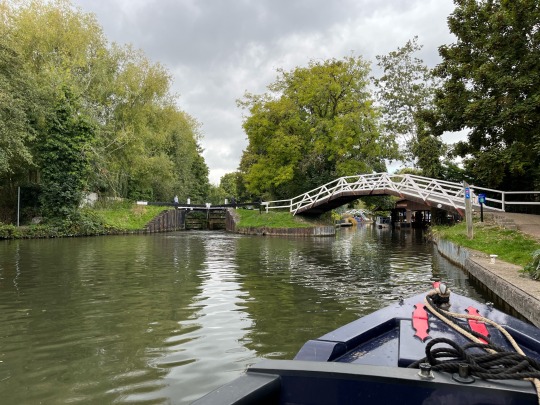
We were fortunate enough to find a mooring right in the middle of Newbury next to Victoria Park, opposite the Cafe on the Canal and the departure point for the trip boat. It was also bird central, from what looked like hundreds of pigeons roosting on the roof of the Library and perched on the crane to the tens of geese, ducks and swans which were loitering around optimistically trying to cadge food from any human unwise enough to put their head out of their boat 😳
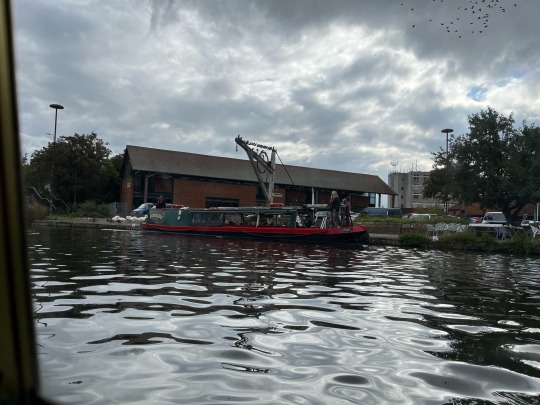
After a rather grey afternoon the weather perked up and while busy talking to my colleague Katherine on Teams, Martin stuck his head round the partition to say he was off to the pub! While this was unusual mid afternoon I thought nothing of it because I was deep in conversation. A little while later I got a text message from him saying, “Can’t you get away from work?”, to my astonishment it was nearly 6 o’clock! I broke off my meeting (sorry Katherine) and headed out along the towpath, to see if I could track Martin down!
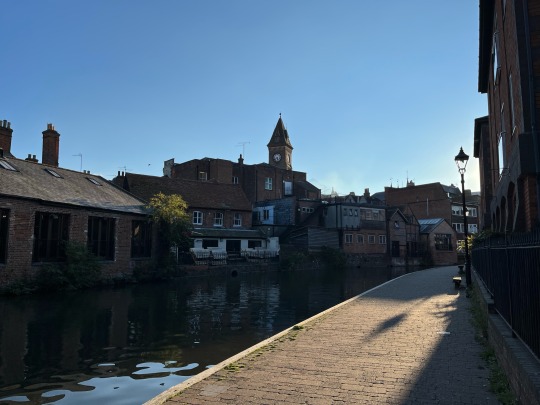
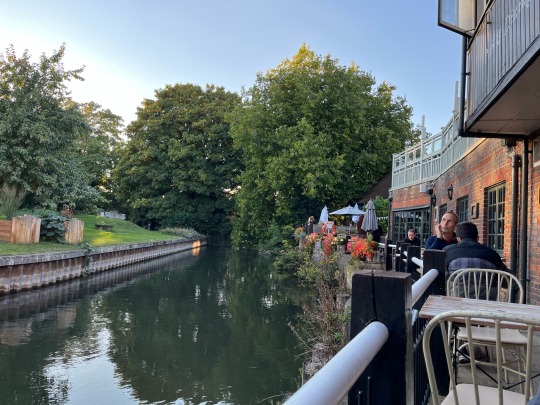
The towpath was delightful, on the opposite side there was an eclectic mix of buildings, several of them hostelries with outside drinking areas overlooking the canal. I managed to find Martin sitting on the veranda of the Lock, Stock & Barrel overlooking Newbury Lock. It was very pleasant as the sun went down but we retreated inside and had the place to ourselves while we enjoyed and evening meal!
The next day was very, very wet! I managed to get out for a walk after work and wandered across Victoria Park and up Northbrook Street, enjoying the mixture of new and old buildings.

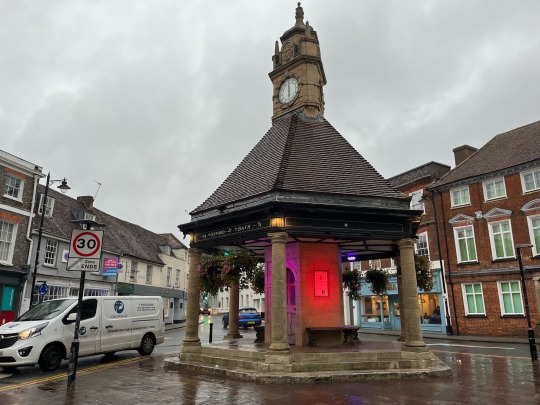
I was rather taken with the metal tree sculpture in the park which has acquired a variety of padlocks which is often a tradition on bridges! Victoria Park used to be called The Marsh but acquired its royal name when a statue of Queen Victoria was unveiled there.
Another interesting building was The Clock Tower, while looking as though it was a meeting point with great historical interest, it was actually designed and built in 1929. It is shaped like a little house with six sides and used to house a telephone although that is long gone! While we think of this as being Newbury, it is actually Speenhamland an area that was of great importance to the coaching trade between London and Bath.


The rain was coming down quite heavily now, but Newbury Town Hall still managed to look imposing. Built in 1881 the mixture of red and grey brick is very decorative. They still have a market twice a week in the market place in front of the clock tower.
The Granary Stores dating from the 17th Century look fascinating and they form part of the West Berkshire Museum, if only it had been open I would have loved to look round. They are on the Wharf, so boats would have come up from Bristol and Bath with their wares and been unloaded into the stores.
By now I am very damp so I take the opportunity to take a picture of Penelope from the Wharf before heading back over the bridge.
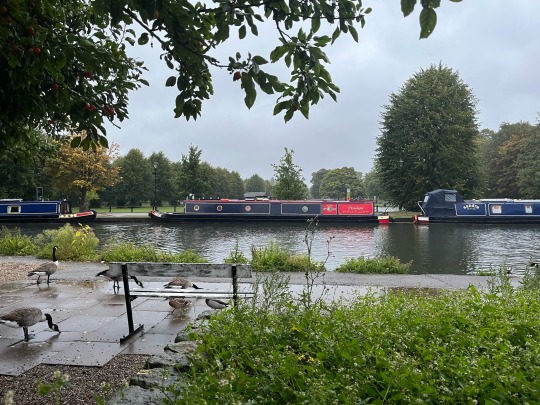
When I get back Martin says that he is concerned about the amount of rain we are experiencing, the problem with being on the river is the very real risk of finding yourself unable to move if they make it Red Boards, particularly the upper bit at Reading and of course the Thames. Mindful that I need to get into London we decide to turn around the next morning and head back to find somewhere to moor for my first trip into the office.
0 notes
Text
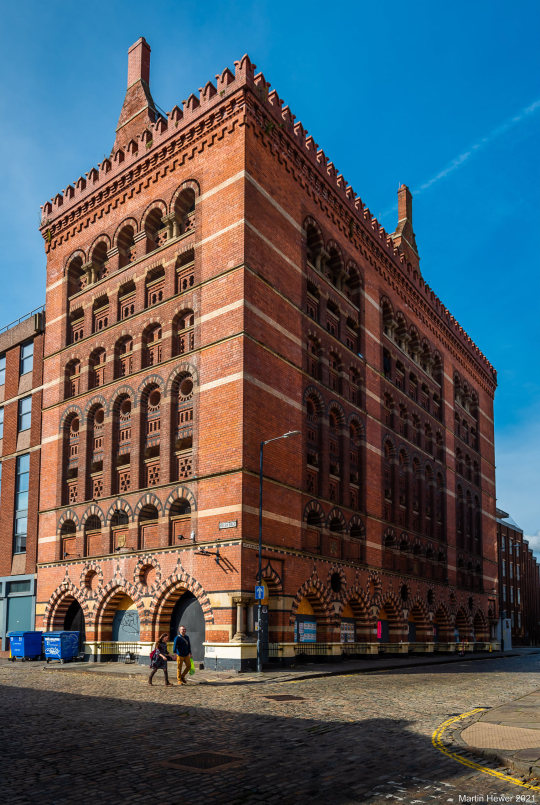
The Old Granary is a building on Welsh Back, Bristol, England.
It was built in 1869 by Archibald Ponton and William Venn Gough with red Cattybrook brick with black and white brick and limestone dressings as a granary but has been used as offices. It is probably the best preserved example of the Bristol Byzantine style.
It housed a nightclub, also known as The Granary, from 1968 to 1988. Initially opened as a jazz club by Ted Cowell under the guidance of Acker Bilk in 1968. It started hosting regular rock nights in 1969, when a collective called Plastic Dog, whose club night had become too busy for the Dugout club on Park Row, took over the poorly attended Monday nights. By early 1970 they had removed 'Old' from the title of the venue, which completed its transition to an all-rock club by 1978. Many well-known rock acts played there, including Yes, Genesis, Status Quo, Motörhead and Iron Maiden.
The building was owned by Bristol City Council who invited competitive bids from developers for its renovation and conversion. Barton Willmore produced the designs which supported the winning bid to convert the building into apartments.
It has been designated by English Heritage as a grade II* listed building.
This image was taken by Martin Hewer
9 notes
·
View notes
Photo
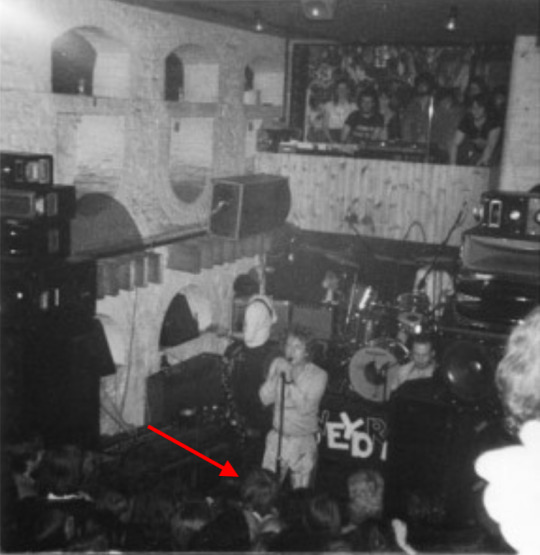
Behold the miracle of the Internet. 40 years on, a photo has surfaced that features me watching Robert Plant do his thing at the Granary Club in Bristol on Tuesday 19th May 1981.
0 notes
Text
PDP Notes 08.10.2019 – Socially Engaged Art
Framework: Art as Educator
Socially engaged art is not an art movement, it is a social trend. Has been the case for at least 15 years.
Books:
Living as Form: Socially Engaged Art
Art School: Propositions for the 21st Century
“What strikes me is the fact that, in our society, art has become something that is related only to objects and not to individuals or to life. That art is something which is specialised or done by experts who are artists. But couldn’t everyone’s life become a work of art? Why should the lamp or the house be an object by not our life?” - Michel Foucault (1983).
Socially engaged art is often considered as activism.
Artist examples:
Rick Lowe – Project Row Houses – 1994-ongoing – Took 22 disused ‘shotgun’ houses in America and turned them into a hub for African-American people. Turning it into something positive after they were previously acquainted by heavy drug-users and prostitution.
Thomas Hirshhorn – The Gramsci Monument – 2013 – community location built from plywood, tarpaulin and tape.
Video: Theaster Gates – How to revive a neighbourhood: with imagination, beauty and art – TED Talk 2015
Socially engaged art – facilitating the change that we want to see.
Local projects to Plymouth:
Plymouth Art Weekender – disused buildings can be used for free. Can be independently organised by me or in a collaborative group. Can be used as our live project for Year 3 professional practice.
Take a Part – arts project for Plymouth communities. Interested in the ecology of the city. How can artists and communities come together to shape things?
Nudge Community Builders & Stonehouse Action (The Clipper) – can rent rooms to showcase work; can use it to sell prints etc.
Tate Exchange – collab between PCA & Tate – usually in January / February. Could put together a curatorial proposal for it based on the year’s theme.
Simon Morrissey (curator) created local art community group in Bristol. Recommended to look at him.
Task:
Choose an artist or artistic community project that captures your imagination or inspires you (very flexible). Write 500 words (minimum) on why it does this – outlining what you can discern as its strengths, outcomes, who it effects and its legacy. Use subheadings to clarify your discussion.
Look the chosen project up from different sources (e.g. websites, articles, reviews) so that the research stems from multiple sources.
Does not necessarily need to be local but has to be current.
Deadline – Tuesday 29th October @ 10am.
Have a look at books to get ideas:
Craftivism Book in the library – community projects creating collaborative quilts for people in need; particularly when natural disasters have hit in the past. Also a lady who started a community group called ‘Stitching for Sisters’ that creates collaborative knitted blankets which were donated to women at Addis Ababa Fistula Hospital in Ethiopia.
Helpful article for relevant socially engaged artists: https://www.widewalls.ch/socially-engaged-art-today/
ICE Project:
Running for 3 years.
Taken from their website (https://www.hampshireculture.org.uk/social-impact/ice-project):
“The ICE Project is an innovative collaboration between Hampshire Cultural Trust and Hampshire Child and Adolescent Mental Health Service (CAMHS).
Since 2017, The ICE Project has engaged 230 at-risk and vulnerable young people aged 11-18 in cultural and creative activities designed to have a positive impact on health and wellbeing. Participants have reported increases in confidence, self-esteem, self-awareness, relaxation and sense of freedom.
The ICE Project’s current funding ends in spring 2020. We need further support for the programme to continue having a positive impact on the mental health of vulnerable and at-risk young people in Hampshire.
This ambitious, innovative programme is a collaboration between Hampshire Cultural Trust and Hampshire Child and Adolescent Mental Health Service, provided by Sussex Partnership NHS Foundation Trust. We set out with the joint view that arts and cultural activities can have a positive impact on our psychological health and emotional wellbeing.
YEAR ONE (2017-2018)
We have been pleased to work with 20 partners and 100 young people on this county-wide programme. The aims of The ICE Project are for young people to:
Experience the positive psychological benefits of participating in the arts
Increase in confidence, self-esteem and social skills
Understand the benefits of arts and culture to maintain a balanced emotional and psychological lifestyle
Express themselves and to comment on important issues
Share their work and opinions with a wider audience
Each strand has included the three elements of ‘Inspire’ through experiencing high quality culture; ‘Create’ through taking part in arts activity; ‘Exchange’ by sharing work at our showcase event.
YEAR TWO (2018-2019)
In its second year The ICE Project worked with 12 groups including 48 young people referred from CAMHS, 90 young people at risk of mental health issues and 580 young people in mainstream schools
Our aims in the second year were:
To INSPIRE young people in Hampshire to connect with their own mental health through arts and culture
For young people to participate in arts activities and CREATE artwork, in order to acquire skills, express themselves and experience a personal journey
For young people to EXCHANGE their ideas, opinions and advice about mental health with the public and feel a sense of achievement.
In 2018-19 the youth partners were: Aldershot CAMHS, Fareham Family Autistic Spectrum Support, Fareham & Gosport CAMHS, Hampshire CAMHS Specialist Eating Disorder Team, Hampshire County Council Children in Care team, Hampshire Foster Carers Network, Romsey Young Carers, Simon Says Child Bereavement Charity, Winchester Schools’ Pastoral Teams, Winchester & Test Valley CAMHS and Y Services.
The arts & cultural partners were: Ashcroft Arts Centre, BearFace Theatre, Forest Arts Centre, Fluid Motion Theatre, Granary Arts Centre, In Focus, Integr8 Movement, Laurence Rushby, My Friendly Planet, Sarah Gaiger, SoCo Music, Strong Island Media, The Colour Factory, The Point, We Are All Creative and West End Centre.
Our thanks to the funders: Artswork, on behalf of Arts Council England, Sussex Partnership NHS Foundation Trust, The Barker-Mill Foundation and individual donors to Hampshire Cultural Trust.
YEAR THREE (2019-2020)
We're currently matching artists and cultural organisations with youth providers for the third and final year of this programme. Activity will commence in Autumn 2019 - Spring 2020.
Hampshire Cultural Trust and Hampshire CAMHS have been shortlisted for a Health Service Journal award, in the 'Mental Health Innovation of the Year' category 2019. In this short film some of our young people share their thoughts about the benefits of The ICE Project.
Hampshire Cultural Trust was established as an independent charity in 2014 to promote Hampshire as a county that offers outstanding cultural experiences to both its residents and visitors.
From museums to galleries to arts centres, we manage and support 23 attractions across the county that were previously operated by Hampshire County Council and Winchester City Council.
We run a huge variety of workshops, classes, events and projects for both young and old, in schools and in communities, with particular emphasis on reaching people who are vulnerable or disadvantaged and would not normally be able to access arts and culture. In addition, we care for 2.5 million objects that relate to Hampshire’s rich and internationally important cultural heritage.”
Which one do I choose and why?
I have chosen to write about the ICE Project as it is very relevant to me. I used to work for Hampshire CAMHS so am interested in finding more out about the programme and how it has benefitted young people on the waiting list for mental health services. It will also be interesting to find out about the Hampshire Cultural Trust in terms of potential art-related job prospects/opportunities in my home town.
0 notes
Text
The Demon Drink
Towards the end of my tenure at Broadridge, my team and I were being hit with almost daily crises. For the last 3 months, it was a nightmare. I was frequently woken up in the middle of the night and then spending hours on conference calls with most of the responsibility resting on my shoulders. The pressure was extreme and it was also coming from unfriendly quarters - full of accusation and no attempt at understanding what I was actually dealing with - which exacerbated the stress.
I ended up working from home quite often and I’d fire up with a whisky when I started work some time around 10 am. And then I’d keep on going. It was my treat. I didn’t drink to get drunk and I very rarely did, but during the course of the entire day, I’d end up having 9 or 10 drinks. Sometimes, when I’d had an especially tough day “I’d think “Fuck it, I’ll take the brakes off today!” Or perhaps, I’d jump in the hot-tub and drink a whole bottle of bubbly in amongst my normal drinking load and I’d end up a bit woozy. But, most of the time I wouldn’t feel drunk and to be honest, I don’t even like the feeling of being drunk. I’d only enjoy being drunk when I was in a social setting and used the drink as a lubricant to get a bit wild and to be less inhibited.
But, when I started on my day drinking on weekends and work at home days, the actual drinking became less and less enjoyable but it was nevertheless the only thing I looked forward to and I couldn’t stop it. I knew that it wouldn’t deliver what I wanted, but I had the anticipation and hoped that somehow this time it would be different. After, I lost my job, it was all day every day. I’d try to hold off until midday, but often took a couple of belts of whisky whenever I finally got downstairs.
I remember how much fun I used to have, coming back home to Bristol from Exeter Uni, opening the fridge, knocking up my favorite sandwich of granary bread, a thick slice of Suffolk ham, sliced pickled cucumber, tomato, lettuce and mayo and then, hopefully, a can of Heineken, which would absolutely taste like nectar.
I still really enjoyed my beer for many years after that, to greater and lesser degrees. But, I didn’t do much drinking at home for a long time. In my latter Wimbledon days, I didn’t go out that much and I’d have 2 or 3 cans of beer at home. I could get that initial warm buzz as it fizzed its way through my stomach walls. I’d drink Holsten Pils and then I got a bit of a thing for strong lagers like Kestrel Extra or Tennents Super Lager and occasionally Carlsberg Special brew. The first couple of big gulps and I’d be almost feel tingling in my fingers.
I only drank beer - no whisky, G&T or anything like that. My unfinished bottle of Wild Turkey sat on the shelf for years.
When I got to the US, I didn’t drink much at home - I guess I didn’t need to - I was probably out at least 4 days a week and having a good few pints every time.
At home, I’d probably only drink a couple of beers. I’d buy in a 30 pack of Bud Ice and it would last me for a while.
I remember really enjoying my ice cold lagers in Greece in 2004. Despite drinking and eating a lot, I didn’t really succumb to feeling bloated and sick and I didn’t really have to shut down at any point.
I would also really enjoy my Sunday night beers at Trinity on the waterfront, where I would also tuck into a burger.
I still really enjoy my beer in the bar on occasions, but often, I’m kind of neutral about it. I’m drinking to be in the bar, rather than drinking because I really fancy a drink.
I suppose that it would be fair to say that my first G&T after work would be quite enjoyable. I’d be thinking about it on my drive home and because I hadn’t had one all day, the anticipation was genuine. It would be the first thing I’d sort out once I was in the front door and then I’d just keep drinking them 3,4 or 5, with a few snifters of whisky thrown in.
But after the first one, I’d think a mixture of “Well, that didn’t quite hit the spot, let’s have another one and hope that this one does.” and “Let’s consider this second drink as a continuation of the first and maybe this pseudo longer drink will work.” The drinking equivalent of chasing the dragon, without there ever being a dragon. But the fact that I was only starting to drink in the early evening, say 6:30 pm, that I didn’t need to exercise huge control to avoid getting blitzed.
With my all-day drinking, I’d be trying to put the brakes on all the time. I would say that I was definitely drinking more overall, but not massively, maybe 9 or 10 drinks in total as opposed to maybe 7. The whisky’s are generally smaller at 1 - 1.5 oz and the G&T’s are now about 2 oz, but used to be more like 2.5 to 3.
My at home beers are virtually never enjoyable - neutral at best. I switch when I can’t stomach another G&T or whisky and think of my old memories of enjoying beer.
So, in the last few days, I’ve tried hard to cut down. Not having my first drink until 2 or 3 pm and then struggling mightily thereafter. Yesterday, I felt like I hardly had a drink, but I’d still had 4 drinks.
0 notes
Text
The Elusive Granary: Herder, Farmer, and State in Northern Kenya (Peter D. Little) soon to be presented for sale on the lustrous BookLovers of Bath web site!
Published: Cambridge, New York, Port Chester, Melbourne & Sydney: Cambridge University Press, 1992, Hardback in dust wrapper.
Number 73 in the series. Laid in 5pp ms. by Paul Spencer dated 1992. Contains: Black & white photographs; Diagrams; Maps; Tables; References;
From the cover: This book examines the social and political dimensions of Africas current food and environmental crises. Written by an anthropologist, it focuses on the changes and the problems faced during this century by one particular eth…
In the African Studies series.
Good in Good Dust Wrapper. A little rubbing to the edges of the dust wrapper which is heavily faded at the spine. Previous owners’ name to the head of the title page. Extensive pencil underlining and marginalia throughout the text, from the working library of Paul Spencer, one of the leading British social anthropologists of his generation, from whose estate this was acquired.
Brown boards with Gilt titling to the Spine. [XIV] 212 pages. Index. 9¼” x 6″.
Of course, if you don’t like this one, may I fascinate you with a carefully selected medley featured in my Anthropology catalogue?
1117411
img00022 20100814 1746
war graves men
img00048 20100928 1257
img00049 20100928 1258
img00051 20100928 1541
hazlebrouk
1673191
170003
170016
e172964
image001
image0011
image0012
the bed that knew how to fly frances maitland nimmo frederick warne co
the bed that knew how to fly frances maitland nimmo frederick warne co b
the bed that knew how to fly frances maitland nimmo frederick warne co c
the bed that knew how to fly frances maitland nimmo frederick warne co d
the bed that knew how to fly frances maitland nimmo frederick warne co e
image1
image001
image0011
image0012
image0013
j howard jacobson jonathan cape 9780224101974
more than a game the story of crickets early years john major harperpress 9780007183647
quayside bristol the city and its port in recent years frank shipsides robert wall redcliffe press 1872971962
flora britannica the definitive new guide to wild flowers plants and trees richard mabey sinclair stevenson 18561937721
irek mukhamedov the authorised biography jeffery taylor fourth estate 185702074x
the opium eater selections from the autobiography thomas de quincey the cresset press
frank richards the chap behind the chums mary cadogan viking 0 670 81946 8
a midnight clear william wharton jonathan cape 0224020501

meriwether nevin tom doherty associates 0 312 86307 1
The Elusive Granary: Herder, Farmer, and State in Northern Kenya (Peter D. Little) The Elusive Granary: Herder, Farmer, and State in Northern Kenya (Peter D. Little) soon to be presented for sale on the…
#0-521-40552-1#africa#agriculture kenya#agropastoral systems#baringo district#books in the african studies series#books written by peter d. little#cultural anthropology#droughts#first edition books#njemps african#rural communities#science social#social conditions#society
0 notes
Text
Railways spelt end of the line for Grand Assembly Room
Railways spelt end of the line for Grand Assembly Room
An interesting article regarding the Lion Ballroom. My sister’s future husband worked at Alexander & Duncan’s in the 1960s, before becoming its owner. Despite going into the works numerous times, I was not aware of the secret history upstairs. A child in his early teens was occupied with so many other things. The Lion Ballroom and the associated buildings have a long and important place in the history of Leominster. We should be grateful to all those who worked so hard to preserve and restore it.
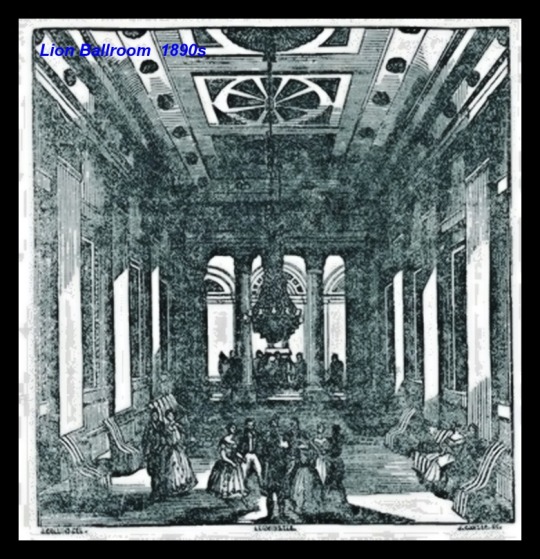
Ballroom dancing has an important place in the life of my wife and I. Mr Mann an excellent teacher at Green Lane Leominster Secondary Modern School taught us Ballroom Dancing in the 1960s. The lessons were every Friday evening in the main hall during the winter months. The music was provided by 78 records played on a wonderful 1940s Gramophone player. It was also the beginning of my love of vinyl records. The Hall like the rest of the school had been an army camp during World War 2. Although the school did have newer buildings housing the Science Block, Gardening and Music rooms.
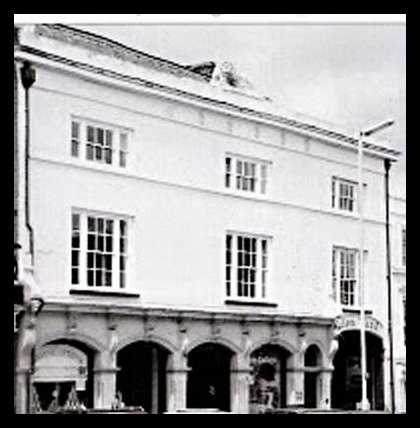
ANYONE WITH STORIES ABOUT THIS SCHOOL PLEASE LET ME KNOW. Over 80% of Leominster’s children attended this school for two decades and yet there are no public records! Enter a search for Leominster Grammar School in Google and their hundreds of results Less than 15% of Leominster children attended this school. I attended both Schools and they were excellent in different ways.
It remains Leominster’s forgotten school.
Chris Upton’s article titled the ‘Lost Lion of Herefordshire ‘follows. It is both informative and entertaining.
Source:
https://www.birminghampost.co.uk/lifestyle/nostalgia/chris-upton-tells-tale-lion-6125548
We are well accustomed to an old building being described as a “best kept secret” or a “forgotten treasure” – it’s all part of good tourist PR.
All the same, it’s remarkable how, on our overcrowded and much scrutinised island, a building can go missing. Even if, as in this case, it is 60ft long and 22ft wide.
Such is surprisingly the case with the Lion Hotel in Leominster. Not so much the old hotel itself, since it stands in the middle of Broad Street and can hardly put on dark glasses on that account, but the Lion Ballroom behind it. Pevsner overlooked the room, and the Department of Environment removed it – despite an earlier listing at Grade II* – from its schedule of listed buildings.
Perhaps there are so many lion hotels – in a wide variety of colours – in this part of England that you can easily mislay one without noticing.
The Leominster Lion stands on the west side of Broad Street, the road that runs north-south through the middle of the town. The eponymous beast peering down from its parapet, looks more docile than its rampant counterpart at Shrewsbury, reflecting perhaps the more sedate pace of life for Herefordshire big cats.
This was not always the case. The road concerned – variously called High Street and Broad Street – was once the busiest of thoroughfares. Head this way for Hereford and Bristol to the south, and for Shrewsbury and Liverpool to the north. And an east-west route, from London to the Welsh border at Kington, passed this way too.
As a result, a host of hostelries clustered along the length of the street, all offering food and accommodation to the weary traveller and hungry trader passing through the town. There were at least nine inns along here at one time, from the Waterloo Hotel at the top end to the Unicorn at the bottom. Only one of them survives as a hotel today.
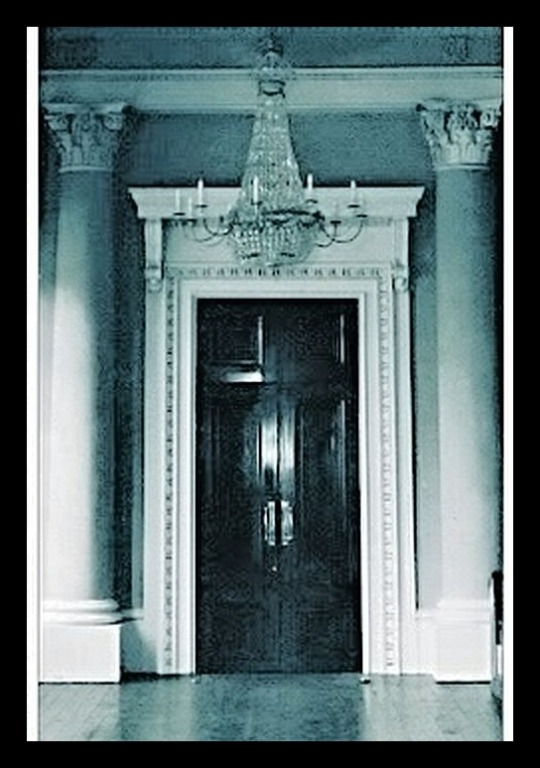
There was a Red Lion on this site from at least the mid-18th Century, doubtless popular with the stall-holders and farmers frequenting the market outside. In the local press each successive lease-holder “begged the indulgence of his friends and the public”, and promised “excellent wines and liquors and unremitting assiduity and attention”.
But the Georgian coaching trade was about to transform Leominster into a major service station, and by the 1830s nine stage and mail coaches were calling at the Red Lion each day. The Red Lion did not have the monopoly, but it was by some distance the major coaching destination in the town.
Sales particulars from the 1830s show that the inn had a granary and stables for the horses, capacious cellars, a walled garden, a cider mill, and “numerous” bedrooms. Evidently the estate agent couldn’t be bothered to count them.
However, the reputation of a good coaching inn was not founded entirely on such passing trade. Its local good-standing was based on the presence of an assembly room, a place for cards and dancing and polite Georgian chit-chat. By the early 1800s the Red Lion had cornered this market as well.
It was when an ambitious Leominster lawyer by the name of James Thomas Woodhouse took over the lease of the Red Lion in 1839 that the hotel’s assembly room was turned from necessary amenity to star attraction.
Woodhouse purchased the property next door in order to expand the hotel’s frontage and add a carriage-way and built a grand new assembly room at the rear. A local architect, John Collins, designed the room in fashionable neo-classical style, all Corinthian columns and candelabra. Leominster had seen nothing like it.
The new assembly room was ready for its first revellers by Christmas 1843, and a succession of balls, concerts and meetings made good use of it. But the truth was that the ex-Red Lion and new Lion Hotel and its assembly room had come just a little too late. The assembly was a declining fashion, the railway was approaching, and the coaching trade was about to be killed stone-dead. Even the styling in the ballroom, you could argue, was now out of fashion. What you have on your hands, sir, is a dead lion.
Ironically, one of the last grand balls ever held at the Lion (in December 1853) was to celebrate the opening of the Ludlow to Hereford railway line. For the hotel too, it was shortly to be the end of the line.
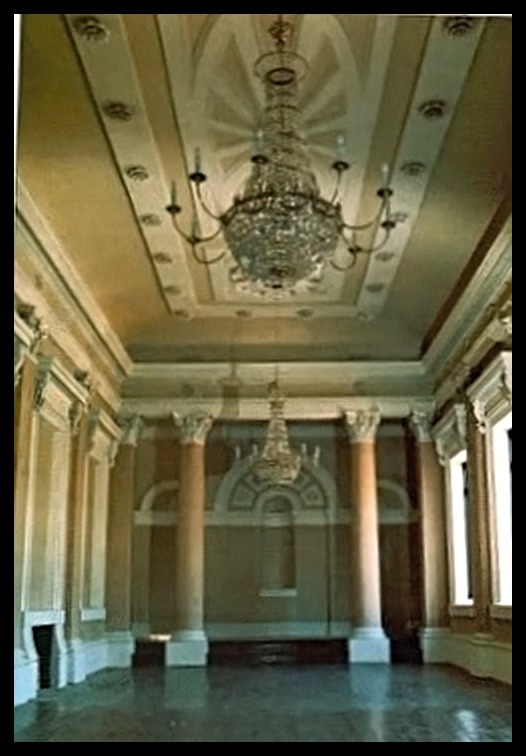
After some years of disuse, in 1861 the building was taken over by a Quaker ironmonger – Samuel Alexander – and became the Lion Implement Warehouse. The former assembly room served as his rather grand showroom, and it continued in that guise for the next century or so. By the 1960s many had forgotten just what the place was, and that included Nikolaus Pevsner. The plasterwork was falling off, and the grand entrance doors had made their exit elsewhere.
However, there’s to be no unhappy ending to this story, and we can celebrate an early Victorian masterpiece brought back from the brink.
With money from the district and town councils, and from the National Lottery, the Lion and its assembly room has been restored to its pristine best. It reopened in 1997. The age of assemblies may have departed, but there’s still a call for concerts and weddings and…er… karate classes.
Not quite what John Collins and James Woodhouse had in mind, perhaps, but there you are.
0 notes
Text
[:en]Bristol Byzantine[:]
[:en]Bristol Byzantine is a variety of Byzantine Revival architecture that was popular in the city of Bristol from about 1850 to 1880.
Many buildings in the style have been destroyed or demolished, but notable surviving examples include the Colston Hall, the Granary on Welsh Back, the Carriage Works, on Stokes Croft and several of the buildings around Victoria Street. Several of the warehouses…
View On WordPress
#Architectural history#Brick buildings and structures#Byzantine Revival architecture#History of Bristol#Moorish Revival architecture#Victorian architectural styles
0 notes
Photo
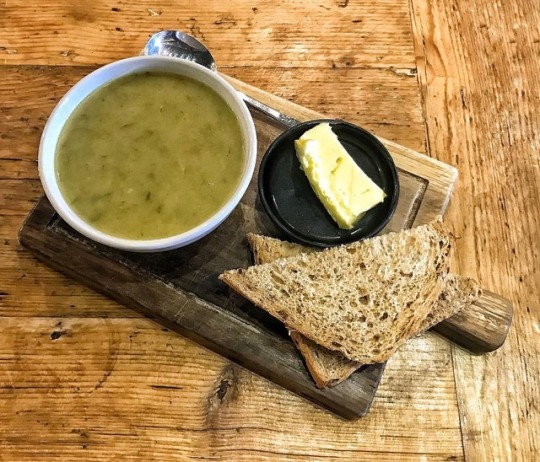
LEEK & POTATO SOUP🌟 Granary bread and butter. Today I’m working all day so, a warm soup will be a perfect alternative on a very cold weather. Do you want me to cook a special soup? Any idea in particular? Let me a comment below. . . . . #cookyourlife #cookyourlifecommunity#lunch#saturday#soup#nutritionalrecipes#nutrition#nutritionist#foodieblogger#food#londonfoodie#bristolfoodie#eatfresh#eatorganic#warmfood#loveyourself#keepgoing#fitness #weekend#food52 (at Bristol, United Kingdom)
#loveyourself#eatfresh#lunch#soup#eatorganic#nutritionalrecipes#food#bristolfoodie#food52#warmfood#keepgoing#nutrition#cookyourlife#saturday#foodieblogger#londonfoodie#weekend#cookyourlifecommunity#nutritionist#fitness
0 notes
Text
Granary in Bristol
Granary in Bristol #architecture
Granary in Bristol, The Wait and James’ Granary, Bristol Byzantine style, Cattybrook brick, Grade II listed building England, built in 1869 by Archibald Ponton and William Venn Gough
Granary in Bristol
View On WordPress
0 notes
Text
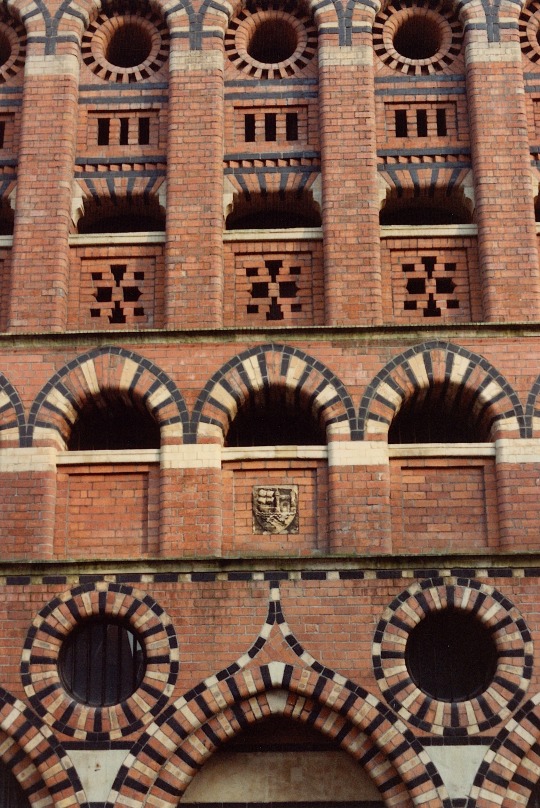
The Old Granary - Bristol
Various Coloured Bricks of the Facade of the Old Granary in Bristol. A famous Jazz venue in the 1960's then a Rock Club from 1969 to 1988 and now its now Club/Restaurant and the upper floors are to be converted into apartments. It was built in 1869 by Archibald Ponton and William Venn Gough with red Cattybrook brick with black and white brick and limestone dressings as a granary. It is probably the best preserved example of the Bristol Byzantine style
16 notes
·
View notes
Photo



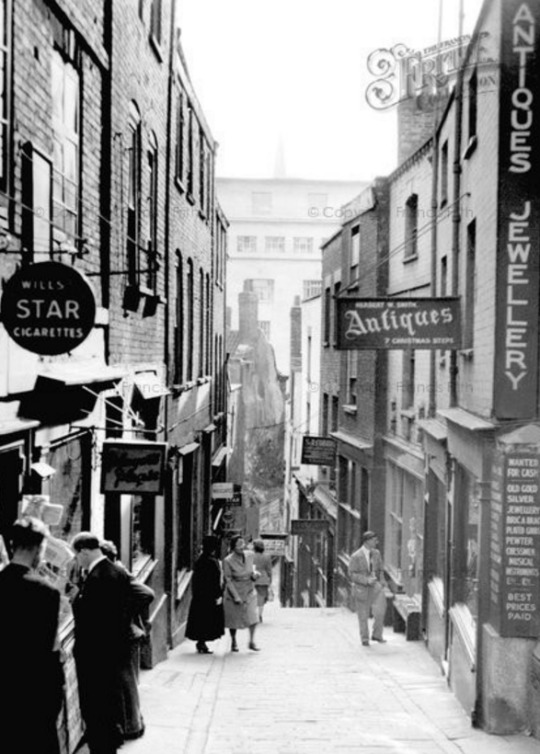
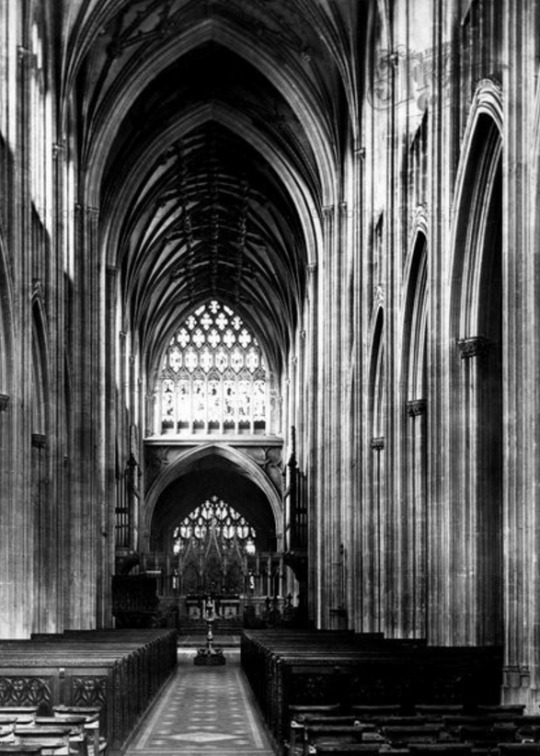
About Bristol
Images From: http://www.francisfrith.com/bristol/photos
There is a combination of architectural styles in Bristol, ranging from the medieval style to the 20th-century modern architecture. During the mid 19th century, Bristol developed a unique style ‘Bristol Byzantine’, and several examples have survived to this day, such as The Granary building, and Colston Hall. Some churches date right back to medieval times.
The city expanded after the University was Built and the start of the aircraft. During world war 2, the city was badly bombed during the Bristol Blitz. Bristol was one of the main targets during world War 2, due to its harbour and aeroplane company. There was a total of 6 bombing raids, killing 1299 people, destroying 3000 building and damaging 90,000. The main industries before the war were aircraft, chocolate, tobacco, engineering, chemicals, zinc, furniture and pottery. The redevelopment of shopping centres, office buildings and the harbour side continue to this day, however a lot of the redevelopment that happened involved the demolition of some of Bristol’s older buildings that couldn’t be repaired.
City Centre- In one of the images above you can see the city centre over 100 years ago. People would sell things on the streets to earn a few shillings a day. Outside of shops, many businesses would paint signs gold to attract customers and advertise their shop. A popular service in Bristol was the tramway that ran through the city centre, however in 1941 it was destroyed by a bomb and never repaired,
0 notes